Optimization of Thiolated Chitosan Nanoparticles for the Enhancement of in Vivo Hypoglycemic Efficacy of Sitagliptin in Streptozotocin-Induced Diabetic Rats
Abstract
:1. Introduction
2. Materials and Methods
2.1. Materials
2.2. Methods
2.2.1. Experimental Design
2.2.2. Preparation of SGN–TC nanoparticles
2.2.3. Particle Size Analysis (Y1)
2.2.4. Determination of Entrapment efficiency % (Y2)
2.2.5. In Vitro Drug Release Studies (Y3)
2.2.6. Optimization of Formulation Variables
2.2.7. Study of the Effect of TC Concentration on the Properties of SGN–TC Nanoparticles
Mucoadhesion Study of SGN–TC Nanoparticles
In Vitro Release Study
Infrared (IR) Spectroscopy
Particle Size and Zeta Potential Analysis
Determination of the Surface Morphology of SGN–TC Nanoparticles
2.2.8. In-Vivo Study
Induction of Diabetes and Experimental Groups
2.2.9. Statistical Analysis
3. Results and Discussion
3.1. Optimization of Formulation Factors of SGN Loaded TC Nanoparticles
3.2. Study of the Effect of Formulation Factors (X1, X2, and X3) on the Responses (Y1, Y2, and Y3)
3.2.1. Effect of the Formulation Factors on the Particle Size (Y1)
3.2.2. Effect of the formulation factors on the Entrapment Efficiency (Y2)
3.2.3. Effect of the Formulation Factors on Drug Release (Y3)
3.3. Optimization of Formulation Factors
3.4. The Effect of TC Concentration on Mucoadhesive Properties and in Vivo Efficacy of SGN–TC Nanoparticles
3.5. In Vitro Mucoadhesive Study
3.6. In Vitro Release of SGN from Prepared SGN–TC Nanoparticles
3.7. In Vitro Release Kinetics
3.8. Fourier Transform Infrared Spectroscopy (FTIR)
3.9. Particle Size and Zeta Potential of SGN–TC Nanoparticles
3.10. The Surface Morphology of SGN–TC Nanoparticles
3.11. Oral Efficacy of SGN–TC Nanoparticles
4. Conclusions
Author Contributions
Funding
Acknowledgments
Conflicts of Interest
References
- Fabiano, A.; Piras, A.M.; Uccello-Barretta, G.; Balzano, F.; Cesari, A.; Testai, L.; Citi, V.; Zambito, Y. Impact of mucoadhesive polymeric nanoparticulate systems on oral bioavailability of a macromolecular model drug. Eur. J. Pharm. Biopharm. 2018, 130, 281–289. [Google Scholar] [CrossRef]
- Nair, A.B.; Sreeharsha, N.; Al-Dhubiab, B.E.; Hiremath, J.G.; Shinu, P.; Attimarad, M.; Venugopala, K.N.; Mutahar, M. HPMC-and PLGA-Based Nanoparticles for the Mucoadhesive Delivery of Sitagliptin: Optimization and In Vivo Evaluation in Rats. Materials 2019, 12, 4239. [Google Scholar] [CrossRef] [Green Version]
- SreeHarsha, N.; Ramnarayanan, C.; Al-Dhubiab, B.E.; Nair, A.B.; Hiremath, J.G.; Venugopala, K.N.; Satish, R.T.; Attimarad, M.; Shariff, A. Mucoadhesive particles: A novel, prolonged-release nanocarrier of sitagliptin for the treatment of diabetics. BioMed. Res. Int. 2019, 2019. [Google Scholar] [CrossRef] [Green Version]
- Harsha, S.; Attimard, M.; Khan, T.A.; Nair, A.B.; Aldhubiab, B.E.; Sangi, S.; Shariff, A. Design and formulation of mucoadhesive microspheres of sitagliptin. J. Microencapsul. 2013, 30, 257–264. [Google Scholar] [CrossRef]
- Kast, C.E.; Bernkop-Schnürch, A. Thiolated polymers—thiomers: Development and in vitro evaluation of chitosan–thioglycolic acid conjugates. Biomaterials 2001, 22, 2345–2352. [Google Scholar] [CrossRef]
- Prajapati, S.K.; Tripathi, P.; Ubaidulla, U.; Anand, V. Design and development of gliclazide mucoadhesive microcapsules: In vitro and in vivo evaluation. AAPS Pharm. Sci. Tech. 2008, 9, 224. [Google Scholar] [CrossRef] [Green Version]
- Duggan, S.; Cummins, W.; O’ Donovan, O.; Hughes, H.; Owens, E. Thiolated polymers as mucoadhesive drug delivery systems. Eur. J. Pharm. Sci. 2017, 100, 64–78. [Google Scholar] [CrossRef]
- Chen, S.; Cao, Y.; Ferguson, L.R.; Shu, Q.; Garg, S. Evaluation of mucoadhesive coatings of chitosan and thiolated chitosan for the colonic delivery of microencapsulated probiotic bacteria. J. Microencapsul. 2013, 30, 103–115. [Google Scholar] [CrossRef]
- Shahnaz, G.; Perera, G.; Sakloetsakun, D.; Rahmat, D.; Bernkop-Schnürch, A. Synthesis, characterization, mucoadhesion and biocompatibility of thiolated carboxymethyl dextran–cysteine conjugate. J. Controlled Release 2010, 144, 32–38. [Google Scholar] [CrossRef]
- Baynes, H.W. Classification, pathophysiology, diagnosis and management of diabetes mellitus. J Diabetes Metab 2015, 6, 1–9. [Google Scholar]
- Millotti, G.; Laffleur, F.; Perera, G.; Vigl, C.; Pickl, K.; Sinner, F.; Bernkop-Schnürch, A. In Vivo Evaluation of Thiolated Chitosan Tablets for Oral Insulin Delivery. J. Pharm. Sci. 2014, 103, 3165–3170. [Google Scholar] [CrossRef]
- Richter, B.; Bandeira-Echtler, E.; Bergerhoff, K.; Lerch, C. Emerging role of dipeptidyl peptidase-4 inhibitors in the management of type 2 diabetes. Vasc. Health Risk Manag. 2008, 4, 753. [Google Scholar] [CrossRef] [Green Version]
- Scott, L.J. Sitagliptin: A Review in Type 2 Diabetes. Drugs 2017, 77, 209–224. [Google Scholar] [CrossRef]
- Scheen, A.J. Pharmacodynamics, efficacy and safety of sodium–glucose co-transporter type 2 (SGLT2) inhibitors for the treatment of type 2 diabetes mellitus. Drugs 2015, 75, 33–59. [Google Scholar] [CrossRef]
- Wu, X.; Liu, C.; Chen, H.; Zhang, Y.; Li, L.; Tang, N. Layer-by-Layer Deposition of Hyaluronan and Quercetin-Loaded Chitosan Nanoparticles onto Titanium for Improving Blood Compatibility. Coatings 2020, 10, 256. [Google Scholar] [CrossRef] [Green Version]
- Mohammed, M.; Syeda, J.; Wasan, K.; Wasan, E. An Overview of Chitosan Nanoparticles and Its Application in Non-Parenteral Drug Delivery. Pharmaceutics 2017, 9, 53. [Google Scholar] [CrossRef] [Green Version]
- Abdelgawad, A.M.; El-Naggar, M.E.; Hudson, S.M.; Rojas, O.J. Fabrication and characterization of bactericidal thiol-chitosan and chitosan iodoacetamide nanofibres. Int. J. Biol. Macromol. 2017, 94, 96–105. [Google Scholar] [CrossRef]
- Sonia, T.A.; Sharma, C.P. Chitosan and its derivatives for drug delivery perspective. In Chitosan for biomaterials I.; Springer: Berlin/Heidelberg, Germany, 2011; pp. 23–53. [Google Scholar]
- Chen, M.-C.; Mi, F.-L.; Liao, Z.-X.; Hsiao, C.-W.; Sonaje, K.; Chung, M.-F.; Hsu, L.-W.; Sung, H.-W. Recent advances in chitosan-based nanoparticles for oral delivery of macromolecules. Adv. Drug Deliv. Rev. 2013, 65, 865–879. [Google Scholar] [CrossRef]
- Zhu, X.; Su, M.; Tang, S.; Wang, L.; Liang, X.; Meng, F.; Hong, Y.; Xu, Z. Synthesis of thiolated chitosan and preparation nanoparticles with sodium alginate for ocular drug delivery. Mol. Vis. 2012, 18, 1973. [Google Scholar]
- Chen, C.-H.; Lin, Y.-S.; Wu, S.-J.; Mi, F.-L. Mutlifunctional nanoparticles prepared from arginine-modified chitosan and thiolated fucoidan for oral delivery of hydrophobic and hydrophilic drugs. Carbohydr. Polym. 2018, 193, 163–172. [Google Scholar] [CrossRef]
- Martien, R.; Loretz, B.; Sandbichler, A.M.; Schnuerch, A.B. Thiolated chitosan nanoparticles: Transfection study in the Caco-2 differentiated cell culture. Nanotechnology 2008, 19, 045101. [Google Scholar] [CrossRef] [PubMed]
- Esquivel, R.; Juárez, J.; Almada, M.; Ibarra, J.; Valdez, M.A. Synthesis and Characterization of New Thiolated Chitosan Nanoparticles Obtained by Ionic Gelation Method. Int. J. Polym. Sci. 2015, 2015, 1–18. [Google Scholar] [CrossRef] [Green Version]
- De Pinho Neves, A.L.; Milioli, C.C.; Müller, L.; Riella, H.G.; Kuhnen, N.C.; Stulzer, H.K. Factorial design as tool in chitosan nanoparticles development by ionic gelation technique. Colloids Surf. Physicochem. Eng. Asp. 2014, 445, 34–39. [Google Scholar] [CrossRef]
- Anitha, A.; Deepa, N.; Chennazhi, K.P.; Nair, S.V.; Tamura, H.; Jayakumar, R. Development of mucoadhesive thiolated chitosan nanoparticles for biomedical applications. Carbohydr. Polym. 2011, 83, 66–73. [Google Scholar] [CrossRef] [Green Version]
- Bravo-Osuna, I.; Schmitz, T.; Bernkop-Schnürch, A.; Vauthier, C.; Ponchel, G. Elaboration and characterization of thiolated chitosan-coated acrylic nanoparticles. Int. J. Pharm. 2006, 316, 170–175. [Google Scholar] [CrossRef] [PubMed]
- Qushawy, M.; Prabahar, K.; Abd-Alhaseeb, M.; Swidan, S.; Nasr, A. Preparation and Evaluation of Carbamazepine Solid Lipid Nanoparticle for Alleviating Seizure Activity in Pentylenetetrazole-Kindled Mice. Molecules 2019, 24, 3971. [Google Scholar] [CrossRef] [Green Version]
- Saremi, S.; Dinarvand, R.; Kebriaeezadeh, A.; Ostad, S.N.; Atyabi, F. Enhanced oral delivery of docetaxel using thiolated chitosan nanoparticles: Preparation, in vitro and in vivo studies. Bio. Med. Res. Int. 2013, 2013. [Google Scholar] [CrossRef]
- Sinha, P.; Udhumansha, U.; Rathnam, G.; Ganesh, M.; Jang, H.T. Capecitabine encapsulated chitosan succinate-sodium alginate macromolecular complex beads for colon cancer targeted delivery: In vitro evaluation. Int. J. Biol. Macromol. 2018, 117, 840–850. [Google Scholar] [CrossRef]
- Ahmed, A.; Ghourab, M.; Shedid, S.; Qushawy, M. Optimization of piroxicam niosomes using central composite design. Int. J. Pharm. Pharm. Sci. 2013, 5, 229–236. [Google Scholar]
- Mahdizadeh Barzoki, Z.; Emam-Djomeh, Z.; Mortazavian, E.; Rafiee-Tehrani, N.; Behmadi, H.; Rafiee-Tehrani, M.; Moosavi-Movahedi, A.A. Determination of diffusion coefficient for released nanoparticles from developed gelatin/chitosan bilayered buccal films. Int. J. Biol. Macromol. 2018, 112, 1005–1013. [Google Scholar] [CrossRef]
- Gaba, P.; Singh, S.; Gaba, M.; Gupta, G.D. Galactomannan gum coated mucoadhesive microspheres of glipizide for treatment of type 2 diabetes mellitus: In vitro and in vivo evaluation. Saudi. Pharm. J. 2011, 19, 143–152. [Google Scholar] [CrossRef] [PubMed] [Green Version]
- Karuna, D.S.; Ubaidulla, U.; Rathnam, G.; Mani, G.; Jang, H.T. Preparation and evaluation of chitosan succinate pellets using extrusion-spheronization technology: Processing and in vitro characterization. Turk. J. Pharm. Sci. 2016, 13, 189–200. [Google Scholar] [CrossRef]
- Sharma, S.; Kumar, A.; Kumar, R.; Rana, N.K.; Koch, B. Development of a novel chitosan based biocompatible and self-healing hydrogel for controlled release of hydrophilic drug. Int. J. Biol. Macromol. 2018, 116, 37–44. [Google Scholar] [CrossRef] [PubMed]
- Abrica-González, P.; Zamora-Justo, J.A.; Sotelo-López, A.; Vázquez-Martínez, G.R.; Balderas-López, J.A.; Muñoz-Diosdado, A.; Ibáñez-Hernández, M. Gold nanoparticles with chitosan, N-acylated chitosan, and chitosan oligosaccharide as DNA carriers. Nanoscale Res. Lett. 2019, 14, 258. [Google Scholar] [CrossRef]
- Qushawy, M.; Nasr, A.; Abd-Alhaseeb, M.; Swidan, S. Design, optimization and characterization of a transfersomal gel using miconazole nitrate for the treatment of candida skin infections. Pharmaceutics 2018, 10, 26. [Google Scholar] [CrossRef] [Green Version]
- Bernkop-Schnürch, A.; Heinrich, A.; Greimel, A. Development of a novel method for the preparation of submicron particles based on thiolated chitosan. Eur. J. Pharm. Biopharm. 2006, 63, 166–172. [Google Scholar] [CrossRef]
- Sohail, M.F.; Javed, I.; Hussain, S.Z.; Sarwar, S.; Akhtar, S.; Nadhman, A.; Batool, S.; Bukhari, N.I.; Saleem, R.S.Z.; Hussain, I. Folate grafted thiolated chitosan enveloped nanoliposomes with enhanced oral bioavailability and anticancer activity of docetaxel. J. Mater. Chem. B 2016, 4, 6240–6248. [Google Scholar] [CrossRef]
- Liu, L.; Zhou, C.; Xia, X.; Liu, Y. Self-assembled lecithin/chitosan nanoparticles for oral insulin delivery: Preparation and functional evaluation. Int. J. Nanomedicine 2016, 11, 761. [Google Scholar] [CrossRef] [Green Version]
- Liu, K.; Qin, M.; Yang, T.; Shi, W.; Tang, M.; Tang, J.; Zhang, W. Preparation, characterization and antioxidation activity in vitro of quercetin loaded chitosan nanoparticles. Chin. J. Biochem. Pharm. 2016, 36, 17–21. [Google Scholar]
- Ahmed, A.M.S.; Ghourab, M.M.; Gad, S.; Qushawy, M.K.E. Design, Formulation, and Evaluation of Piroxicam Niosomal Gel. Int. J. PharmTech Res. 2014, 6, 185–195. [Google Scholar]
- Sudhakar, S.; Chandran, S.V.; Selvamurugan, N.; Nazeer, R.A. Biodistribution and pharmacokinetics of thiolated chitosan nanoparticles for oral delivery of insulin in vivo. Int. J. Biol. Macromol. 2020, 150, 281–288. [Google Scholar] [CrossRef] [PubMed]
- Malakar, J.; Nayak, A.K. Formulation and statistical optimization of multiple-unit ibuprofen-loaded buoyant system using 23-factorial design. Chem. Eng. Res. Des. 2012, 90, 1834–1846. [Google Scholar] [CrossRef]
- Chen, K.-Y.; Zeng, S.-Y. Preparation and characterization of quaternized chitosan coated alginate microspheres for blue dextran delivery. Polymers 2017, 9, 210. [Google Scholar] [CrossRef] [PubMed]
- Saboktakin, M.R.; Tabatabaie, R.M.; Maharramov, A.; Ramazanov, M.A. Development and in vitro evaluation of thiolated chitosan—poly(methacrylic acid) nanoparticles as a local mucoadhesive delivery system. Int. J. Biol. Macromol. 2011, 48, 403–407. [Google Scholar] [CrossRef] [PubMed]
- Zhou, S.; Deng, H.; Zhang, Y.; Wu, P.; He, B.; Dai, W.; Zhang, H.; Zhang, Q.; Zhao, R.; Wang, X. Thiolated Nanoparticles Overcome the Mucus Barrier and Epithelial Barrier for Oral Delivery of Insulin. Mol. Pharm. 2020, 17, 239–250. [Google Scholar] [CrossRef]
- Karuna, D.S.; Rathnam, G.; Ubaidulla, U.; Ganesh, M.; Jang, H.T. Chitosan phthalate: A novel polymer for the multiparticulate drug delivery system for diclofenac sodium. Adv. Polym. Technol. 2018, 37, 2013–2020. [Google Scholar] [CrossRef]
- Zhang, P.; Zhang, N.; Wang, Q.; Wang, P.; Yuan, J.; Shen, J.; Fan, X. Disulfide bond reconstruction: A novel approach for grafting of thiolated chitosan onto wool. Carbohydr. Polym. 2019, 203, 369–377. [Google Scholar] [CrossRef]
- Rahbarian, M.; Mortazavian, E.; Dorkoosh, F.A.; Tehrani, M.R. Preparation, evaluation and optimization of nanoparticles composed of thiolated triethyl chitosan: A potential approach for buccal delivery of insulin. J. Drug Deliv. Sci. Technol. 2018, 44, 254–263. [Google Scholar] [CrossRef]
- Tiyaboonchai, W. Chitosan nanoparticles: A promising system for drug delivery. Naresuan Univ. J. Sci. Technol. NUJST 2013, 11, 51–66. [Google Scholar]
- Mahdizadeh Barzoki, Z.; Emam-Djomeh, Z.; Rafiee-Tehrani, M.; Mortazavian, E. Optimization and development of insulin nanoparticles by new thiolated chitosan derivative with ionic gelation method using a model-based methodology. J. Food Bioprocess. Eng. 2019, 3, 43–56. [Google Scholar]
- Ubaidulla, U.; Khar, R.K.; Ahmad, F.J.; Sultana, Y.; Panda, A.K. Development and characterization of chitosan succinate microspheres for the improved oral bioavailability of insulin. J. Pharm. Sci. 2007, 96, 3010–3023. [Google Scholar] [CrossRef] [PubMed]
- Anitha, A.; Deepa, N.; Chennazhi, K.P.; Lakshmanan, V.-K.; Jayakumar, R. Combinatorial anticancer effects of curcumin and 5-fluorouracil loaded thiolated chitosan nanoparticles towards colon cancer treatment. Biochim. Biophys. Acta BBA-Gen. Subj. 2014, 1840, 2730–2743. [Google Scholar] [CrossRef] [PubMed]
- Ariful Islam, M.; Park, T.-E.; Reesor, E.; Cherukula, K.; Hasan, A.; Firdous, J.; Singh, B.; Kang, S.-K.; Choi, Y.-J.; Park, I.-K. Mucoadhesive chitosan derivatives as novel drug carriers. Curr. Pharm. Des. 2015, 21, 4285–4309. [Google Scholar] [CrossRef] [PubMed]
- Ways, M.; Mohammed, T.; Lau, W.M.; Khutoryanskiy, V.V. Chitosan and its derivatives for application in mucoadhesive drug delivery systems. Polymers 2018, 10, 267. [Google Scholar] [CrossRef] [PubMed] [Green Version]
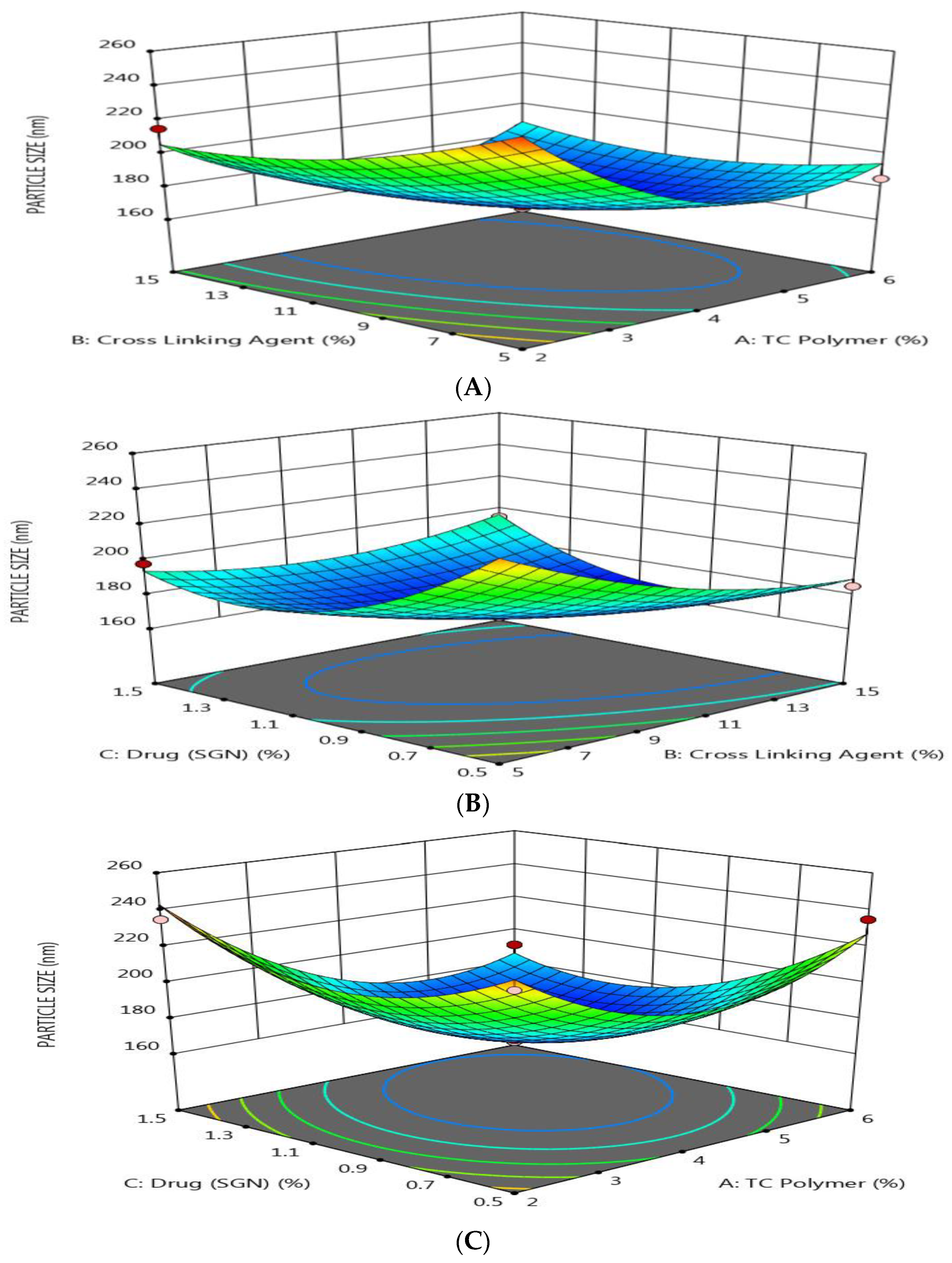
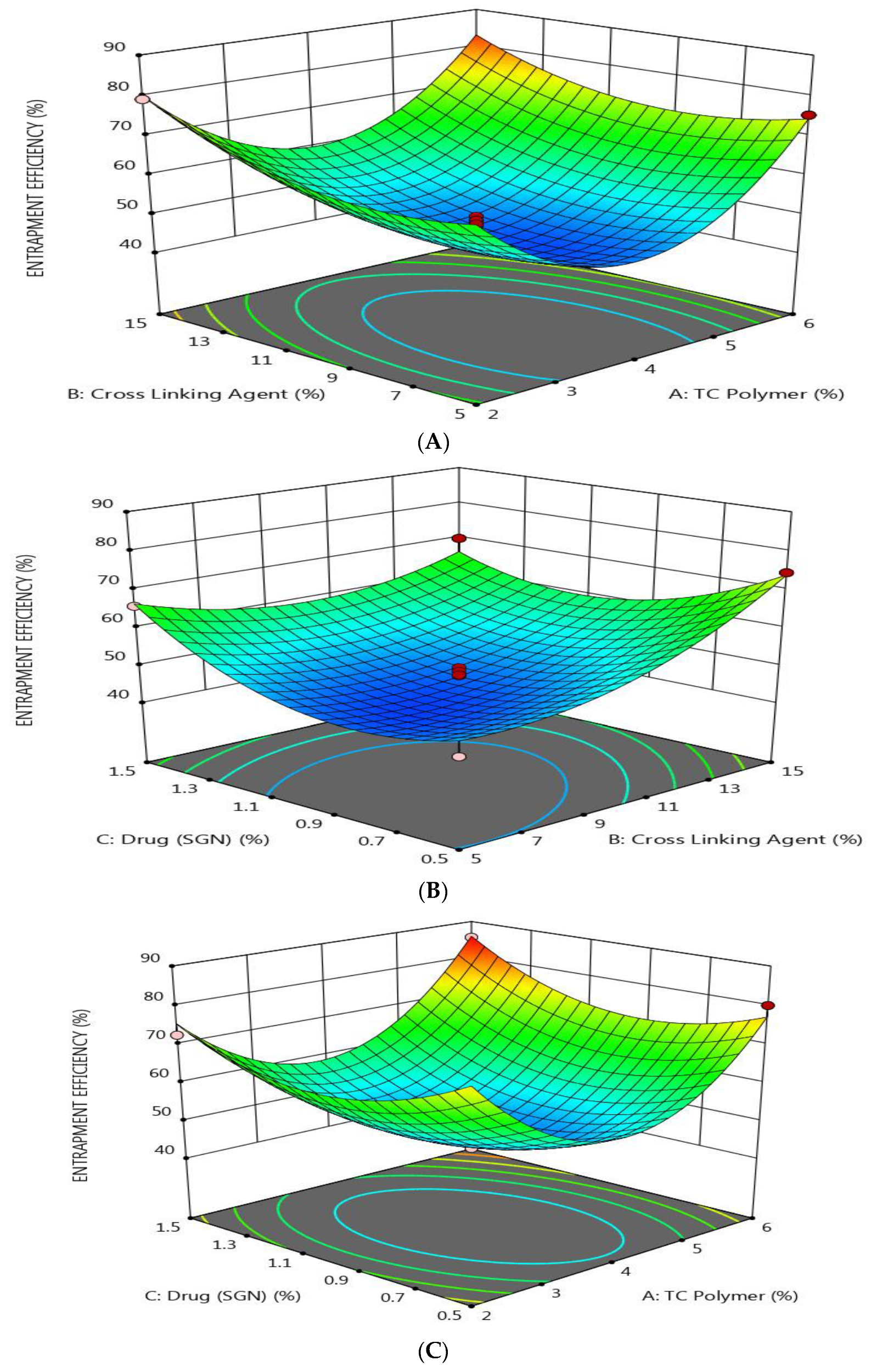
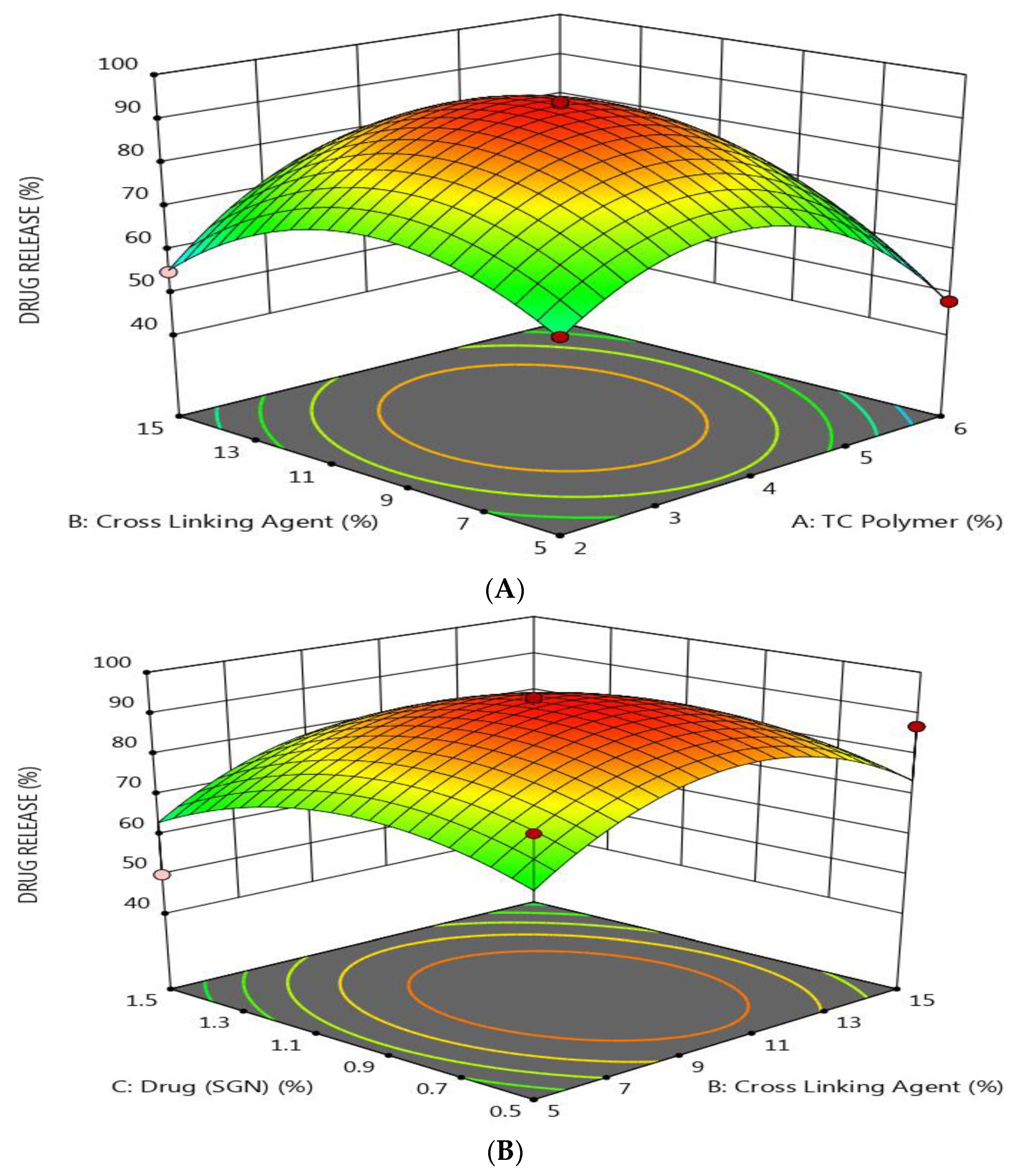
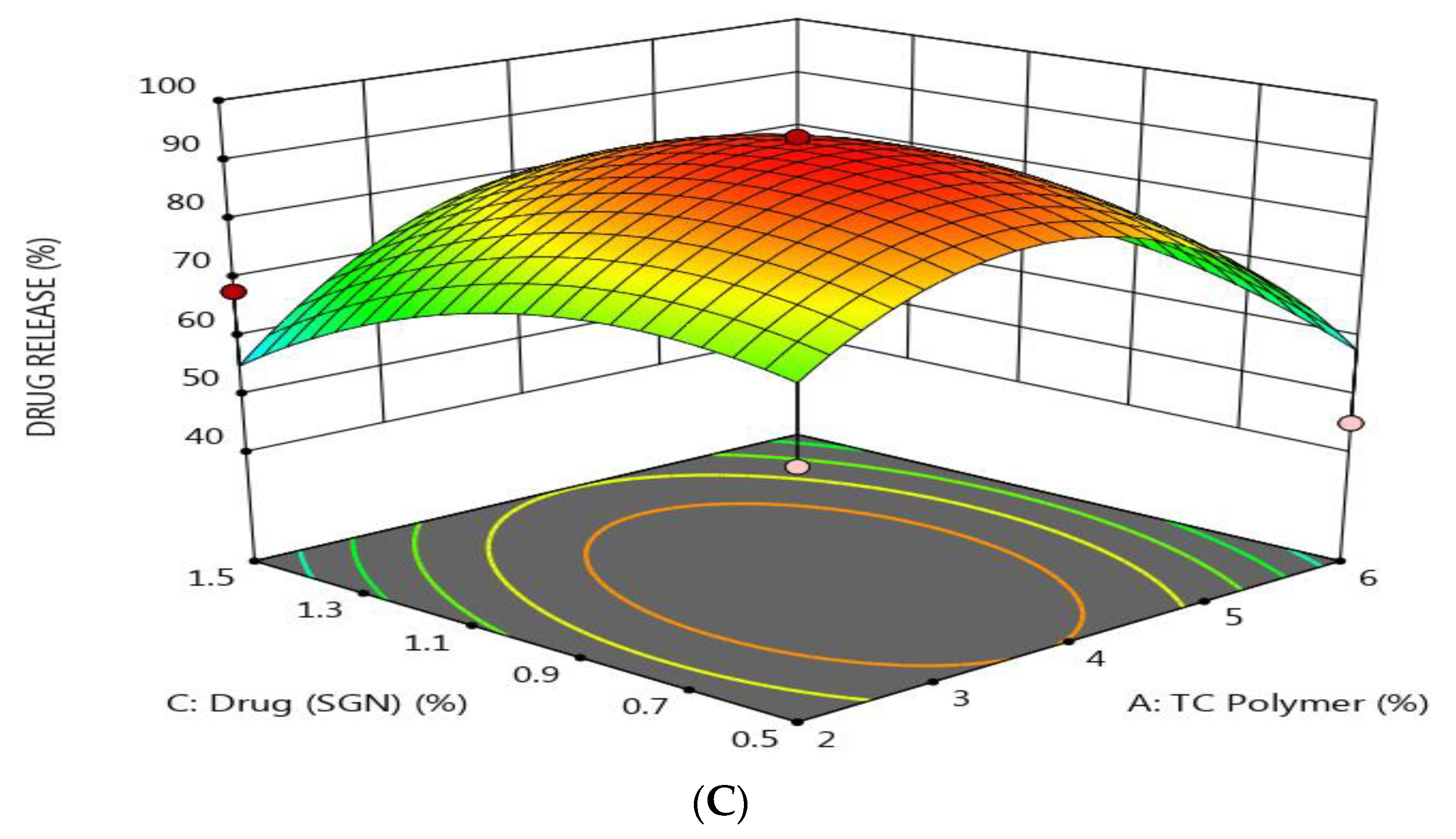
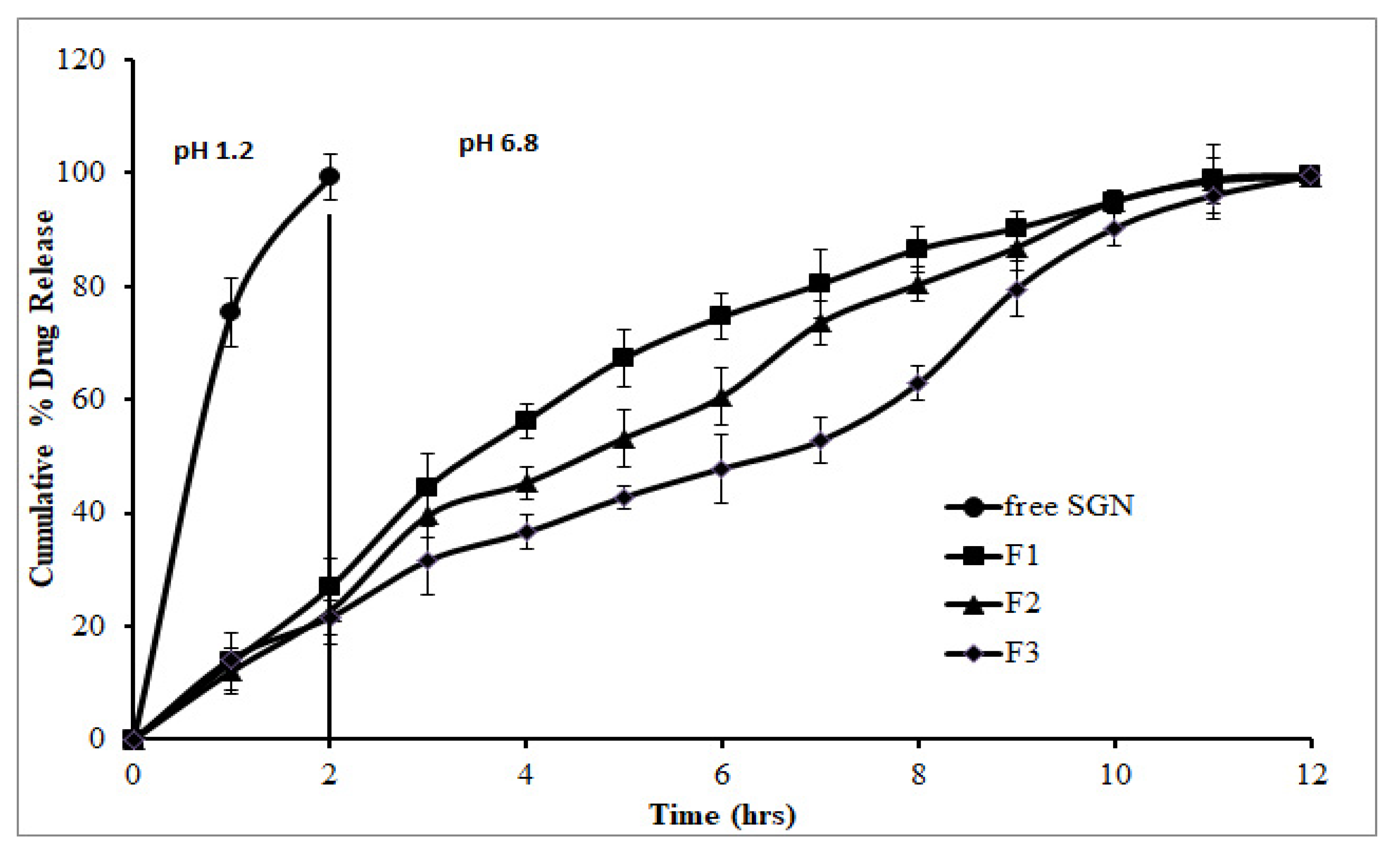
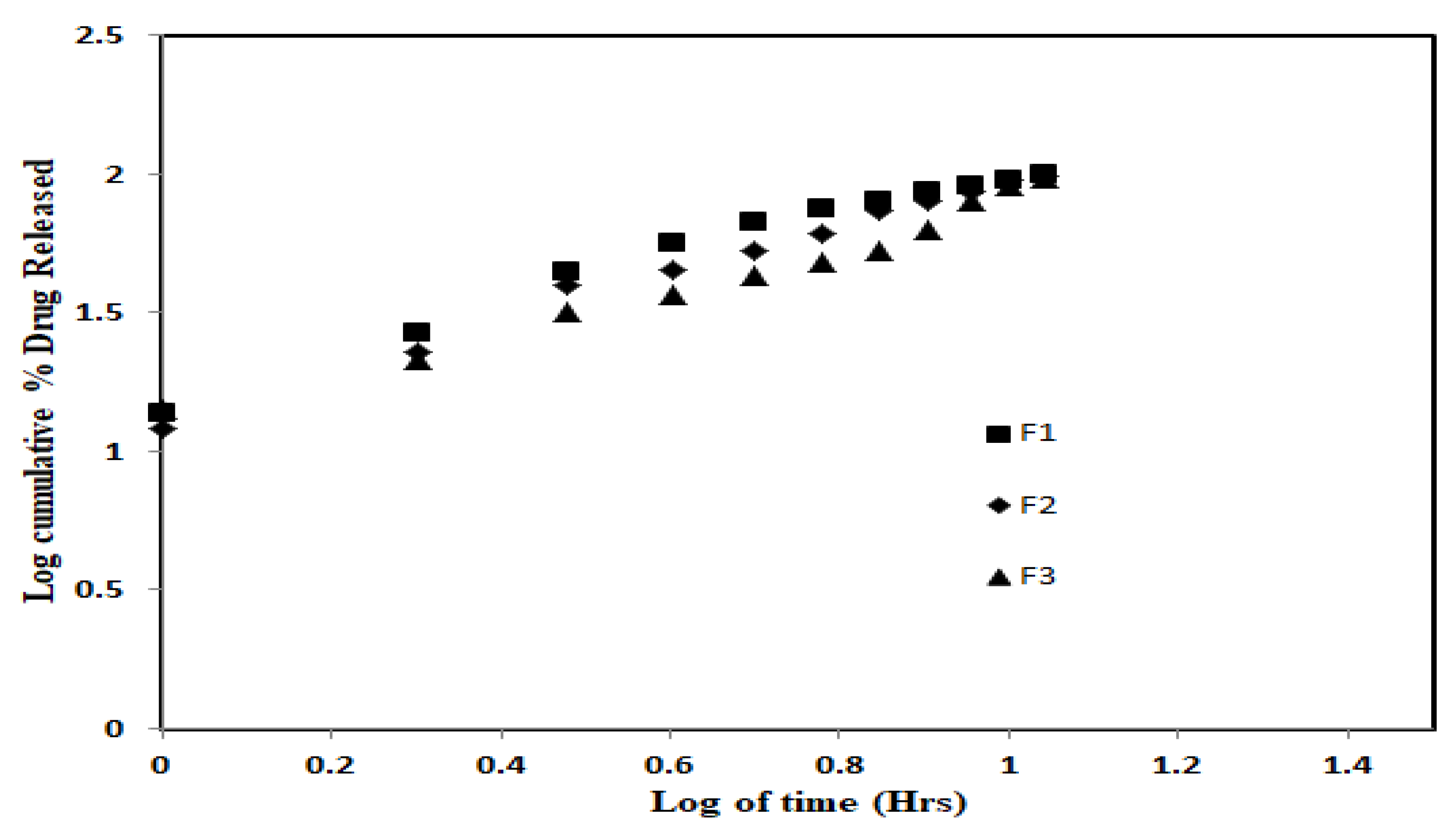
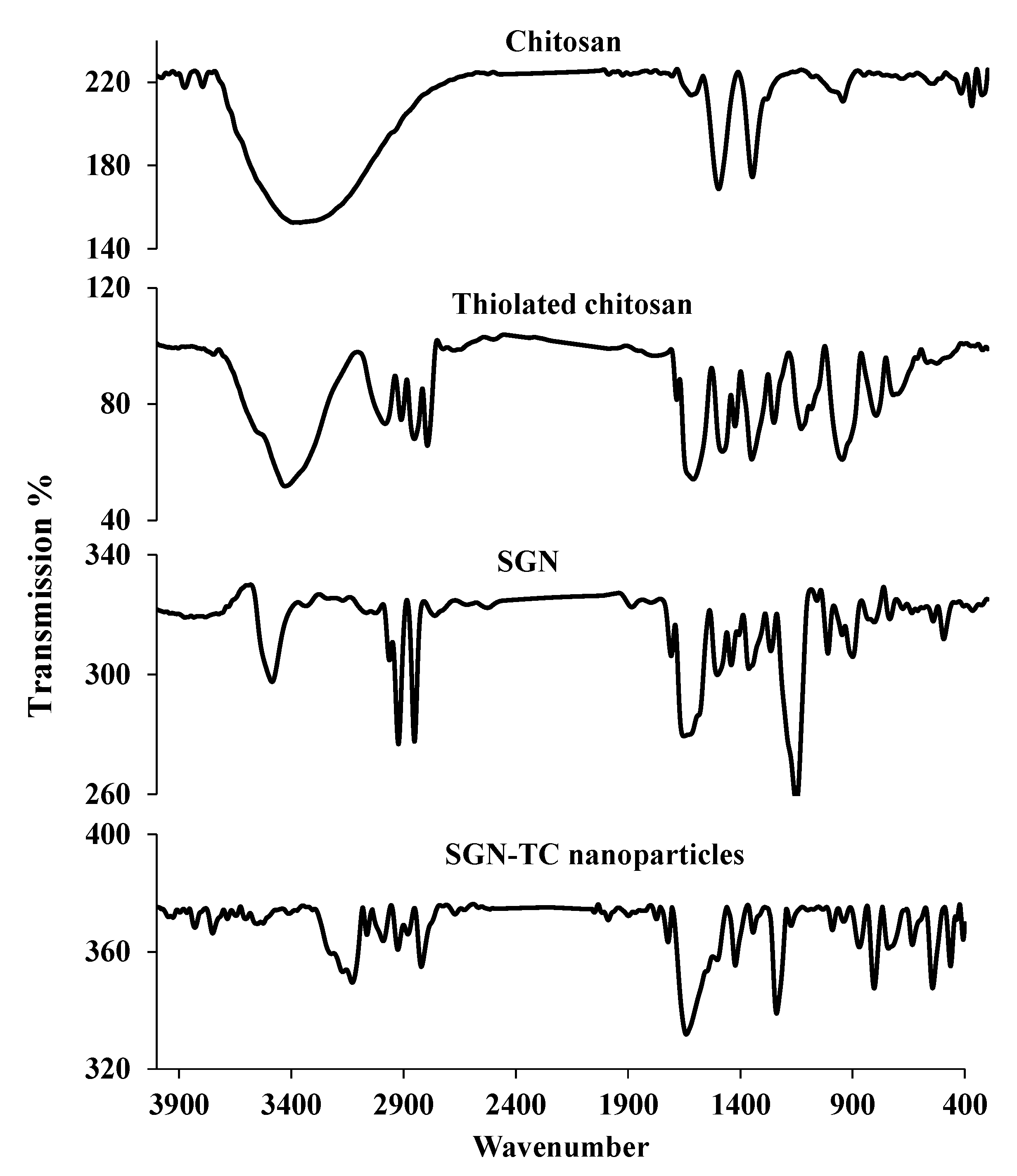
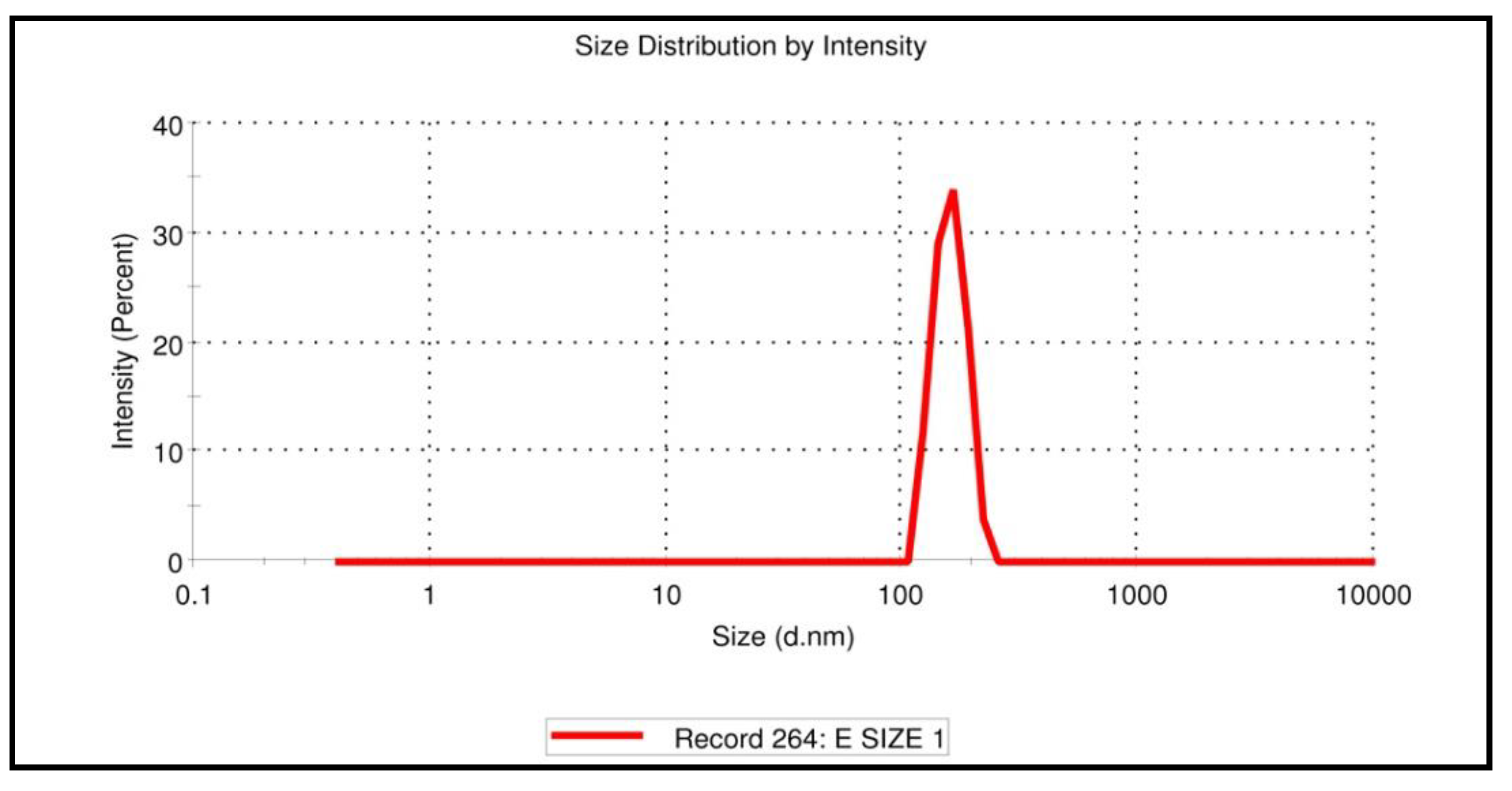
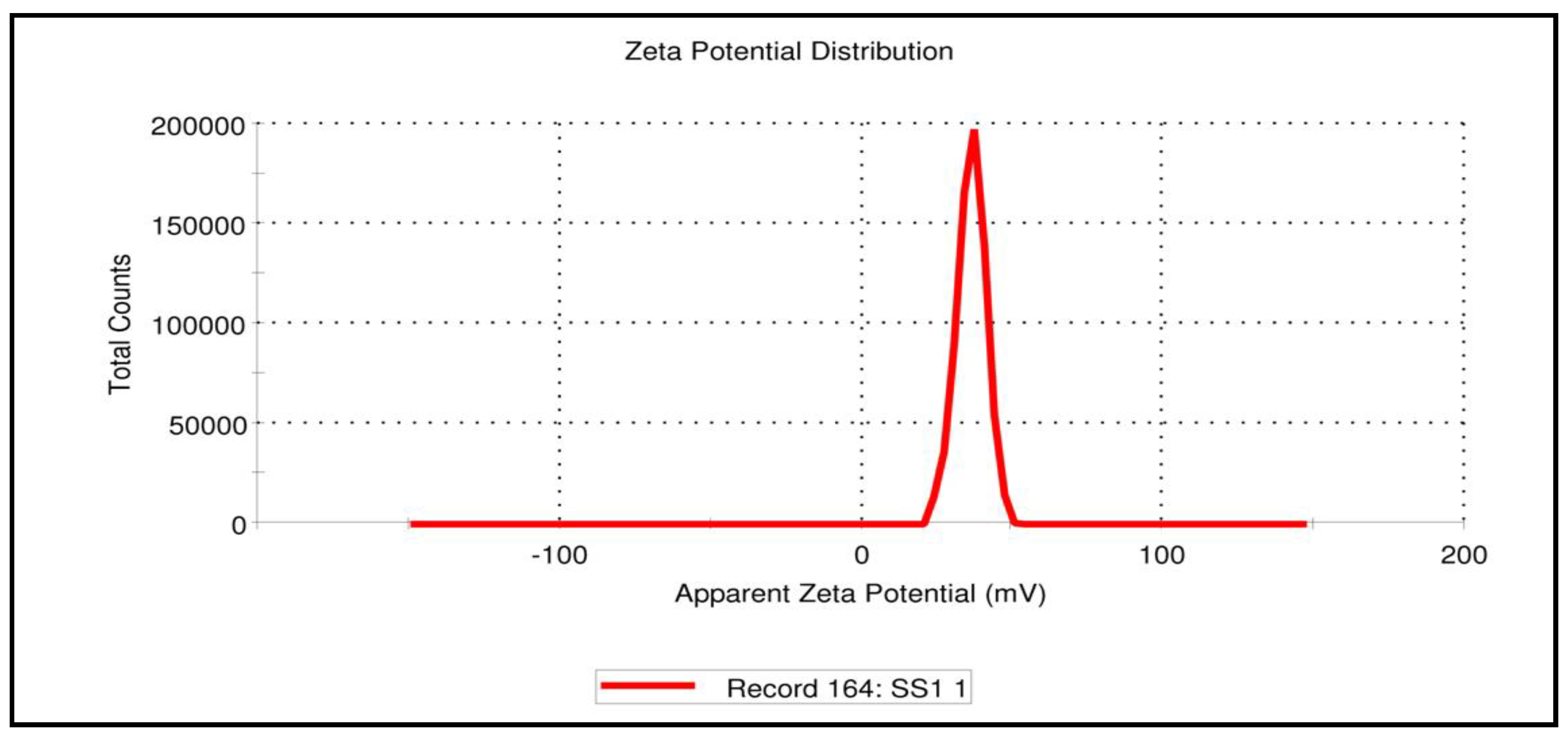
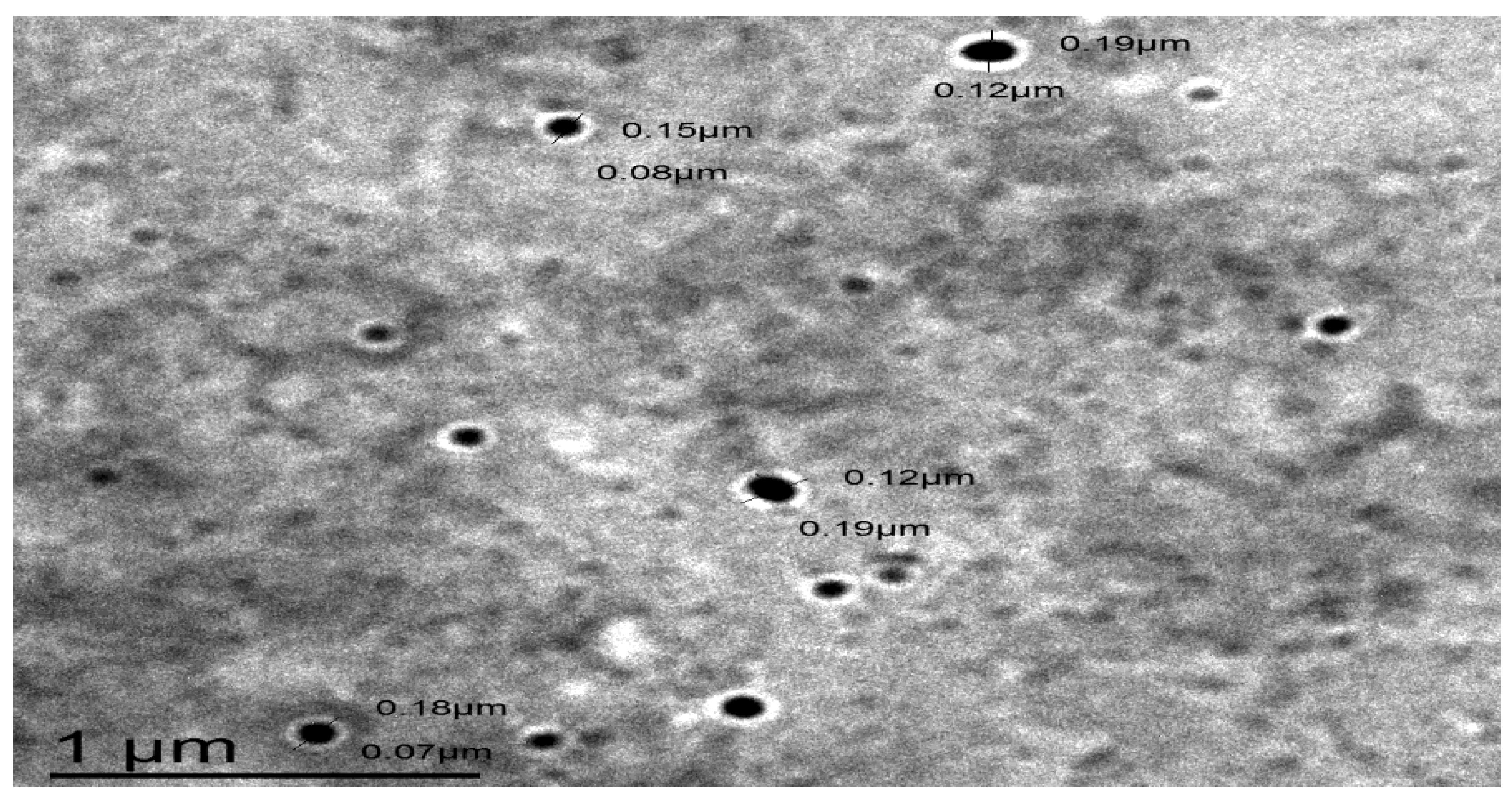
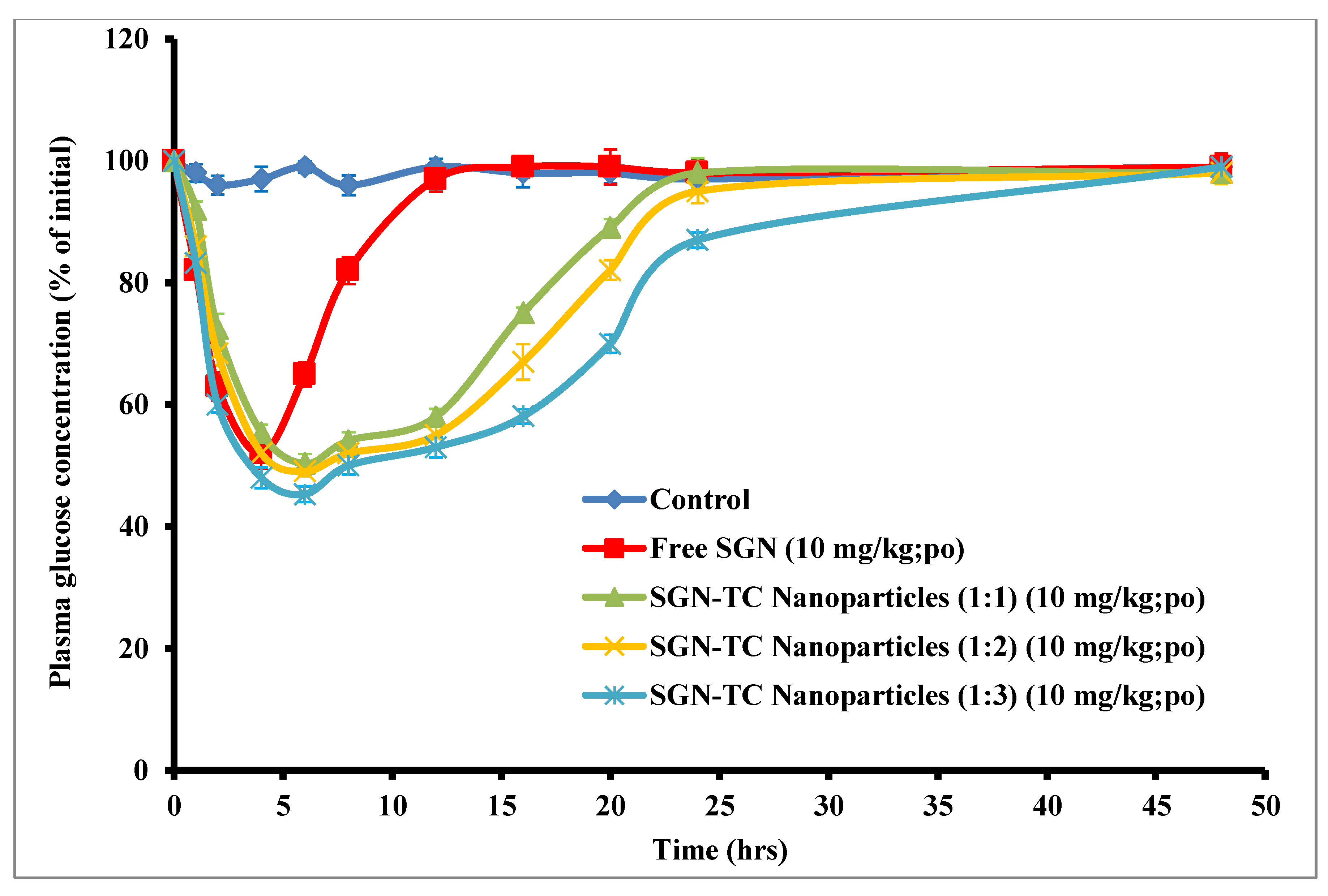
| Level Used | ||||
|---|---|---|---|---|
| Factor | Name | Units | Low (−1) | High (+1) |
| A: X1 | Thiolated Chitosan (TC) | (% w/v) | 2 | 6 |
| B: X2 | Tripolyphosphate (TPP) | (% w/v) | 5 | 15 |
| C: X3 | Sitagliptin (SGN) | (% w/v) | 0.5 | 1.5 |
| Response | Name | Units | Goal | |
| Y1 | Particle Size | Nm | Minimize | |
| Y2 | Entrapment Efficiency (EE) | % | Maximize | |
| Y3 | Drug Release (Q12h) | % | Minimize | |
| Run | X1 | X2 | X3 |
|---|---|---|---|
| A: Polymer (TC) | B:Cross Linking Agent (TPP) | C:Drug (SGN) | |
| % (W/V) | % (W/V) | % (W/V) | |
| 1 | 6 | 10 | 0.5 |
| 2 | 4 | 10 | 1 |
| 3 | 4 | 10 | 1 |
| 4 | 2 | 10 | 0.5 |
| 5 | 4 | 15 | 1.5 |
| 6 | 4 | 10 | 1 |
| 7 | 4 | 15 | 0.5 |
| 8 | 2 | 10 | 1.5 |
| 9 | 6 | 10 | 1.5 |
| 10 | 4 | 5 | 1.5 |
| 11 | 4 | 10 | 1 |
| 12 | 2 | 15 | 1 |
| 13 | 6 | 15 | 1 |
| 14 | 6 | 5 | 1 |
| 15 | 4 | 10 | 1 |
| 16 | 2 | 5 | 1 |
| 17 | 4 | 5 | 0.5 |
| Run | Y1 | Y2 | Y3 | |
|---|---|---|---|---|
| Particle Size nm | Entrapment Efficiency % | Drug Release (Q12h) % | Polydispersity Index (PDI) | |
| 1 | 235 ± 5.26 | 80.11 ± 2.14 | 45.25 ± 1.25 | 0.465 ± 0.07 |
| 2 | 167 ± 3.54 | 48.5 ± 0.95 | 93.13 ± 1.83 | 0.258 ± 0.02 |
| 3 | 166 ± 6.58 | 49.51 ± 2.85 | 92.32 ± 0.85 | 0.321 ± 0.06 |
| 4 | 230 ± 8.47 | 76.44 ± 1.29 | 61.61 ± 1.27 | 0.128 ± 0.03 |
| 5 | 195 ± 7.15 | 69.9 ± 1.64 | 54.11 ± 2.85 | 0.267 ± 0.09 |
| 6 | 168 ± 3.82 | 42.66 ± 0.86 | 94.21 ± 0.97 | 0.436 ± 0.05 |
| 7 | 185 ± 6.24 | 74.53 ± 1.23 | 87.37 ± 1.28 | 0.239 ± 0.06 |
| 8 | 235 ± 7.36 | 72.56 ± 2.46 | 68.39 ± 2.39 | 0.365 ± 0.02 |
| 9 | 191 ± 3.24 | 85.63 ± 3.12 | 77.47 ± 2.44 | 0.487 ± 0.01 |
| 10 | 198 ± 5.34 | 65.82 ± 1.98 | 50.02 ± 1.29 | 0.195 ± 0.04 |
| 11 | 169 ± 6.17 | 47.21 ± 1.56 | 93.45 ± 2.36 | 0.466 ± 0.07 |
| 12 | 215 ± 3.78 | 79.21 ± 2.94 | 55.12 ± 0.86 | 0.369 ± 0.06 |
| 13 | 185 ± 6.82 | 79.55 ± 3.88 | 63.67 ± 1.27 | 0.241 ± 0.03 |
| 14 | 185 ± 2.67 | 75.32 ± 0.97 | 48.20 ± 0.83 | 0.456 ± 0.08 |
| 15 | 167 ± 8.75 | 47.52 ± 1.25 | 93.81 ± 2.63 | 0.366 ± 0.07 |
| 16 | 246 ± 5.22 | 69.32 ± 2.94 | 63.31 ± 1.14 | 0.211 ± 0.09 |
| 17 | 236 ± 4.95 | 46.52 ± 1.82 | 81.89 ± 1.37 | 0.299 ± 0.01 |
| Source | Sum of Squares | DF | Mean Square | F Value | p Value |
|---|---|---|---|---|---|
| Model | 3366.61 | 9 | 374.07 | 25.48 | <0.0001 |
| Residual | 102.78 | 7 | 14.68 | — | — |
| Lack of fit | 75.11 | 3 | 25.04 | 3.62 | 0.1230 |
| Pure error | 27.67 | 4 | 6.92 | — | — |
| Corr. total | 3469.38 | 16 | — | — | — |
| Formulation Code | SGN:TC Ratio |
|---|---|
| F1 | 1:1 |
| F2 | 1:2 |
| F3 | 1:3 |
| Formulation Code | pH 1.2 | pH 6.8 | ||||
|---|---|---|---|---|---|---|
| 1 h | 2 h | 4 h | 6 h | 8 h | 10 h | |
| F1 | 74 ± 5.3 | 59 ± 3.7 | 53 ± 4.1 | 49 ± 3.9 | 23 ± 2.5 | 6 ± 1.4 |
| F2 | 83 ± 4.7 | 72 ± 4.2 | 64 ± 5 | 55 ± 3.4 | 34 ± 2.8 | 14 ± 2.0 |
| F3 | 91 ± 3.0 | 83 ± 2.9 | 70 ± 3.5 | 62 ± 2.8 | 42 ± 1.6 | 21 ± 1.2 |
| Parameters | Free SGN | SGN–TC Nanoparticles (1:1) | SGN–TC Nanoparticles (1:2) | SGN–TC Nanoparticles (1:3) |
|---|---|---|---|---|
| SGN dose (mg) | 10 mg/kg | 10 mg/kg | 10 mg/kg | 10 mg/kg |
| Minimum glucose level in % of the initial level | 52.06 ± 2.86 | 50.32 ± 3.01 | 49.05 ± 2.55 | 47.09 ± 1.91 |
| Time point of minimum glucose level (h) | 4 | 6 | 6 | 6 |
| AAC0→48 | 776.5 ± 8.34 | 2686 ± 6.2 * | 2790 ± 7.5 * | 3681 ± 5.7 * |
| Relative pharmacological efficacy (PA %) | - | 349.9 ± 6.0 * | 359.3 ± 3.8 * | 474.05 ± 3.2 * |
© 2020 by the authors. Licensee MDPI, Basel, Switzerland. This article is an open access article distributed under the terms and conditions of the Creative Commons Attribution (CC BY) license (http://creativecommons.org/licenses/by/4.0/).
Share and Cite
Prabahar, K.; Udhumansha, U.; Qushawy, M. Optimization of Thiolated Chitosan Nanoparticles for the Enhancement of in Vivo Hypoglycemic Efficacy of Sitagliptin in Streptozotocin-Induced Diabetic Rats. Pharmaceutics 2020, 12, 300. https://doi.org/10.3390/pharmaceutics12040300
Prabahar K, Udhumansha U, Qushawy M. Optimization of Thiolated Chitosan Nanoparticles for the Enhancement of in Vivo Hypoglycemic Efficacy of Sitagliptin in Streptozotocin-Induced Diabetic Rats. Pharmaceutics. 2020; 12(4):300. https://doi.org/10.3390/pharmaceutics12040300
Chicago/Turabian StylePrabahar, Kousalya, Ubaidulla Udhumansha, and Mona Qushawy. 2020. "Optimization of Thiolated Chitosan Nanoparticles for the Enhancement of in Vivo Hypoglycemic Efficacy of Sitagliptin in Streptozotocin-Induced Diabetic Rats" Pharmaceutics 12, no. 4: 300. https://doi.org/10.3390/pharmaceutics12040300
APA StylePrabahar, K., Udhumansha, U., & Qushawy, M. (2020). Optimization of Thiolated Chitosan Nanoparticles for the Enhancement of in Vivo Hypoglycemic Efficacy of Sitagliptin in Streptozotocin-Induced Diabetic Rats. Pharmaceutics, 12(4), 300. https://doi.org/10.3390/pharmaceutics12040300







